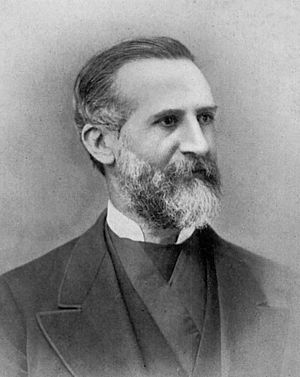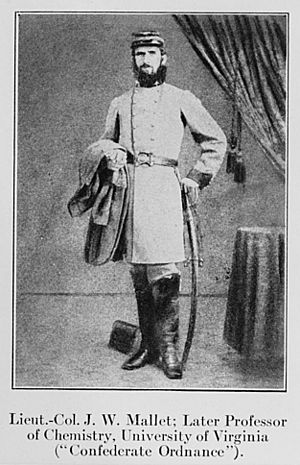John Mallet facts for kids
Quick facts for kids
John William Mallet
|
|
|---|---|
 |
|
| Born | 10 October 1832 Dublin, Ireland
|
| Died | 7 November 1912 (aged 80) Charlottesville, Virginia, US
|
| Nationality | Irish |
| Scientific career | |
| Fields | Chemistry |
| Signature | |
John William Mallet (born October 10, 1832 – died November 7, 1912) was an important Irish chemist. He spent most of his life living and working in the United States. He was also a Fellow of the Royal Society, which is a very respected group of scientists.
Contents
Early Life and Education
John William Mallet was born near Dublin, Ireland. His father, Robert Mallet, was a civil engineer and also a member of the Royal Society. John grew up with many science books in his father's large library.
He started taking private chemistry lessons when he was young. At 17, he went to Trinity College Dublin. He earned his Bachelor of Arts degree there in 1853. While in college, John helped his father study seismology, which is the science of earthquakes. He also won a gold medal for his work in physics.
In 1849, soon after starting college, he published a paper about the chemistry of a place called "Killiney." In the summers of 1851 and 1852, he studied at the University of Göttingen in Germany. He learned from a famous chemist named Friedrich Wöhler and earned another degree in 1852.
Moving to America and War Service
After finishing his studies in Ireland, Mallet moved to the United States in 1854. He stayed there for the rest of his life, though he never became an American citizen. He first became a professor of analytical chemistry at Amherst College.
In 1855, he moved to Alabama to work for the State Geological Survey. He also became a chemistry professor at the University of Alabama. He worked there until the American Civil War began.
When the war started in 1861, Mallet joined the Confederate Army. He first served in the cavalry. Soon after, he became an aide to General Robert E. Rodes. By 1865, he was a lieutenant colonel. He was in charge of the Southern States' ordnance laboratories. This meant he oversaw the chemical work for making military supplies.
A Career in Chemistry and Public Service
After the war ended, Mallet became a chemistry professor at the University of Louisiana. He earned a medical degree (M.D.) in 1868. That same year, he moved to the University of Virginia. This became his main home for the rest of his life.
At the University of Virginia, he taught many types of chemistry. This included analytical, industrial, and agricultural chemistry. He also gave lectures at Johns Hopkins University in 1877 and 1878. For a year, he was a professor and chairman of the faculty at the University of Texas. He also taught at the Jefferson Medical College in Philadelphia. However, he returned to the University of Virginia in 1885 and stayed there.
In 1908, at age 76, Mallet became a professor emeritus. This means he retired but kept his connection to the university. Besides his work during the war, he also took on other important public roles. He was a judge at the Centennial Exposition in 1876. He was also a member of the United States Assay Commission several times. This commission checks the quality of coins.
Mallet was a member of many important scientific groups. These included the Royal Society and the American Chemical Society. He was even president of the American Chemical Society in 1882. He also belonged to the American Academy of Arts and Sciences and the American Philosophical Society. Many universities gave him honorary degrees, including Princeton University and Johns Hopkins University.
Mallet married Mary Elizabeth Ormond in 1857. After she passed away in 1886, he married Josephine Burtlhe in 1888. He had three children from his first marriage, but his first son died young.
In 1961, the University of Alabama created the Mallet Assembly. This is a special program for honors students, named after him. He is buried at the University of Virginia Cemetery.
Key Scientific Discoveries
John Mallet's scientific work covered many areas of chemistry. He studied general chemistry, applied chemistry, and chemical mineralogy.
Some of his important contributions include:
- He found ways to measure organic matter in drinking water.
- He studied meteorites and rare minerals found on Earth.
- He looked at how much silver was in the ash from volcanoes in South America.
- He accurately measured the density of solid mercury.
- He determined the molecular weight of hydrofluoric acid.
- He precisely measured the atomic weights of elements like lithium (in 1856), aluminum (in 1880), and gold. For example, his measurement for lithium (6.943) is very close to what scientists accept today (6.941).
Mallet also worked as an expert witness in many court cases. He helped with cases about poisoning, the value of iron ore, and river pollution.

Images for kids
-
Mallet's gravestone at the University of Virginia Cemetery in Charlottesville, Virginia




